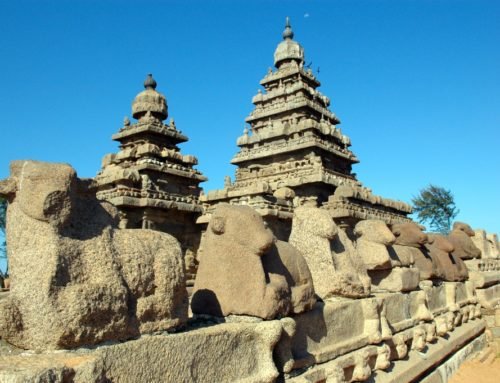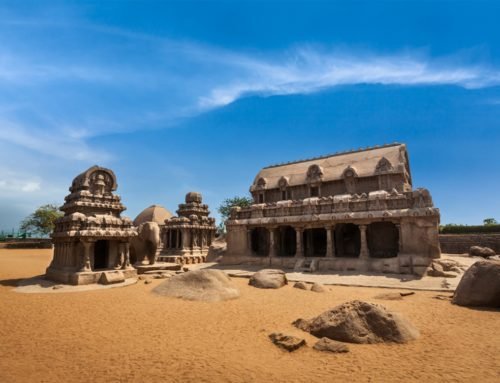Overview
- Features: Hindu cave temple with relief sculptures
- Opening Times: Dawn to dusk, daily
- Best Time to Visit: Late October to early March
- Duration: 20 to 30 mins
- Travelled By: Foot
- Cost: Free
- Address: West of West Raja Street, Mahabalipuram, Tamil Nadu, India
- Type: Historic site
Author Reviews[display_rating_item_results rating_form_id=”2″ rating_entry_ids=”1″ show_category_filter=”false” show_options=”true” result_type=”star_rating” preserve_max_rating=”true” show_title=”false” show_count=”false” ]
Total Rating: [display_rating_result rating_form_id=”2″ show_count=”false” show_rich_snippets=true] [accordions load=”1″] [accordion title=”User Reviews” last] [display_rating_item_results rating_form_id=”5″ show_options=”true” result_type=”star_rating” preserve_max_rating=”true” show_title=”false” show_count=”true” show_rich_snippets=true] [/accordion] [accordion title=”Add Review”][display_rating_form show_email_input=”true” show_comment_textarea=”true” show_name_input=”true” rating_form_id=”5″] [/accordion] [/accordions]
Summary
Built in the late 7th century, the Varaha Cave Temple dedicated to Lord Vishnu, is one of the finest examples of Indian rock-cut cave architecture. The Varaha Cave Temple has beautifully moulded lion pillars, while the relief sculptures of Lakshmi, Durga and Varaha, the boar incarnation of Vishnu, are among the masterpieces of Pallava art.
Varaha Cave Temple Mahabalipuram
West of Arjuna’s Penance is the Varaha Cave Temple dedicated to Lord Vishnu. Built in the late 7th century, it is one of the finest examples of ancient Vishwakarma Sthapathis or Indian rock-cut cave architecture.
The Varaha Cave Temple has beautifully moulded lion pillars, while the relief sculptures of Lakshmi, Durga and Varaha, the boar incarnation of Vishnu, are among the masterpieces of Pallava art. The base forms a narrow water pool for pilgrims to use before entering the temple.
The most prominent sculpture in the cave is that of Lord Vishnu in the incarnated form of a Varaha or boar lifting Bhudevi, the mother earth goddess from the sea. Also carved are many mythical figures. Early Hindu art is rife with depictions of Vishnu in animal form, as opposed to today, when he is primarily worshipped as Rama or Krishna, which suggests this nascent phase of Hindu theology was more closely tied to tribal religions.
[singlepic id=789 w=720 h=560 float=center]
A distinctive feature of the Pallava style is that the frontage of the cave has, without exception, finely carved fluted columns separating the openings with cushion-shaped capitals and seated lions at the base. Certain Greco-Roman architectural styles could also be discerned and the sitting statues are said to have likeness to the sitting styles seen in European architecture, as against the Indian cross legged style.
The walls inside the cave have several striking mythological scenes carved in relief. Vishnu rescuing the earth, Vishnu taking three strides, Gaja Laksmi and Durga are all impressive panels carved in the Varaha Cave Temple.
[singlepic id=791 w=720 h=560 float=center]
At the centre of the rear wall, opposite to the entrance, guardian figures are carved on either side of a shrine. Inside, the walls have four large sculptured panels, good examples of naturalistic Pallava art.
The side walls have carved sculpture panels of Vishnu as Trivikrama, and the northern panel, which is very large, depicts Vishnu as a huge incarnation of Varaha, the boar, lifting Bhudevi, the earth goddess which symbolically represents the removal of ignorance from human beings. In this panel, Varaha has four hands, two arms at the back carrying a shankha and chakra, and in his front arms he is carrying Bhudevi. There are no attendants fawning on him. However, the original panel has been plastered and painted.
[singlepic id=790 w=720 h=560 float=center]
Located on the rear wall, the Gajalakshmi panel is dedicated to Lakshmi, the goddess of prosperity. The religious significance of Gajalakshmi is well brought out in the panel. Carved in perfect beauty and gracious countenance, she is shown holding a lotus flower and fawned by four attendants. Two royal elephants are filling the water vessels held by the attendants; one elephant is pouring water from the vessel on Lakshmi while the other is about to take the vessel from the maiden’s hand to pour water over Lakshmi.
[singlepic id=788 w=720 h=560 float=center]
Another strikingly impressive panel, also on the rear wall, is the Durga panel indicative of victory over ignorance. The panel depicts Durga slaying the demon Mahishasura who is in an anthropomorphic form of a human with a buffalo head; the scene is reminiscent of a battle between good and evil forces, with the side of Durga represented by the confident looking ganas (attendants) advancing and the other side of Mahishasura with his army of asuras (demons) retreating. This scene is a new form of architectural depiction which is used to enhance the drama and realism of the subject.
[singlepic id=787 w=720 h=560 float=center]
The Brahma panel is carved with Brahma having three heads in sambhaga or standing posture while the Trivikrama panel depicts Vishnu as the Lord of the three worlds. Also seen in the cave are panels with carvings of two images of Pallava kings with their queens.
This is the only cave temple in Mahabalipuram where worship is conducted daily in the mornings and evenings.
Getting to & from Varaha Cave Temple
Located adjacent to Arjuna’s Penance, west of West Raja Street, the Varaha Cave Temple can be accessed on foot or by bicycle. A self-guided walking tour of the ruins in Mahabalipuram is an excellent way to see the sites including Varaha Cave Temple. Alternatively, you can speed up your tour on a bicycle which can be hired for the day in town.








I only have 1 day in Mahabalipuram, would you recommend to visit this temple?
Hi Kendrick,
If you only have one day, I would suggest you skip this temple and visit the star attractions of Mahabalipuram – Shore Temple, Arjuna’s Penance and Pancha Rathas (or Five Rathas).
There are so many temple ruins around town that you can simply wander around and see what you find.
Happy and safe travels. 🙂